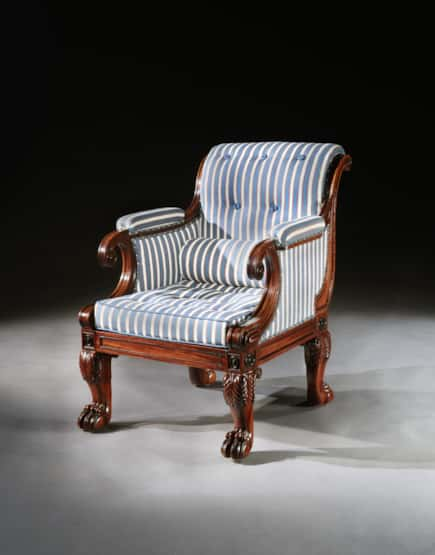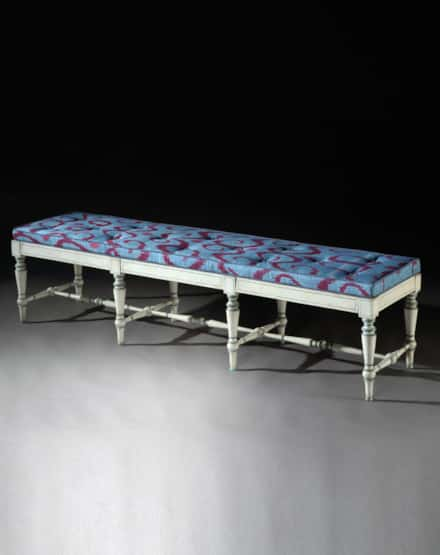A Regency Period Reclining Armchair Designed and Made By William Pocock
Southampton Street, London, 1813
REF 845
H: 43 ½ in (110 cm)
D: 39 ½ in (99 cm)
W:36 in (91.5 cm)
Extended: 73 in (185.5 cm)
PROVENANCE
The Counts
Von Schönburg-Glauchau
At Hinterglauchau and Forderglauchau
DESCRIPTION
The chair with adjustable reclining back upholstered in original Morocco hide. The padded arms again with original upholstery, supported by two massive winged monopodia retaining their original patinated bronze paint finish with mahogany sides and rails with gilt bronze mounts. The front rail with a pull out adjustable footrest supported by a winged griffin. The underside with label marked ‘No. 1’.
This extraordinary armchair is almost identical to a design by William Pocock from March of 1813, which was published by Rudolph Ackerman in ‘The Repository of Arts’, one of the most important and influential books of the early nineteenth century.
The chair has survived in an extraordinary state of preservation retaining its original ‘Morocco’ leather upholstery. The execution of the chair exactly matches the original design by Pocock and it is highly likely to have been made by him and sold in his showroom at 20 Southampton Street, Covent Garden in 1813.
One can only speculate how this chair was in the collection of Count von Schonberg Glauchau at Hinterglauchau. Ackerman himself was born in Leipzig, only fifty miles from the castle. His ‘Repository for Arts’ had international appeal and it is possible the Count was made aware of this ‘patent’ chair through this publication.
WILLIAM POCOCK
(1750 – 1825)
William Pocock was an English furniture maker who specialised in patent furniture in the early 19th century. The patented design for this reclining chair was published in Rudolf Ackerman’s Repository of the Arts in 1813, showing the brass ratchets on the side rails that created coordination in the movement of back and arms.
Pocock initially practiced in the trade of carpentry in London and was made a member of the Carpenters’ Co. by redemption in 1782. By 1786 he was operating an affluent building business in Essex and it was through this connection that he first became interested in the cabinet making trade. From 1801 to 1825 he had showrooms at 26 Southampton Street, London and the business is described in directories up to 1808 as a cabinet and upholstery warehouse. He was known to have patented several designs including this chair in 1813 as well as others such as a dining table that could be extended by a single person turning a handle in 1805. He also offered library tables with rising tops to suit both a standing and seated posture.
In February 1813 Pocock’s Reclining Patent Chair was illustrated in Ackerman’s Repository of the Arts, featuring an adjustable back, a double footstool that could be extended into a couch, and an adjustable reading desk bedecked with carved classical ornament. Pocock appears to have had an ingenious mind and the business acumen to satisfy the public interest in furniture involving mechanical devices.
Ackerman: ”Pocock’s patent reclining principle, to incline the back to any position, with double reclining footstools, which slide from under the chair to extend it when the back is reclined to the length of a couch. A reading desk is attached to the side, and contrived to swing round in from the chair. The whole is designed with classical taste, in the present improved fashion of modern furniture, by the ingenious inventors, Messrs. Pocock’s, of Southampton-street, Covent Garden (Page 72)
METAMORPHIC REGENCY FURNITURE IN LONDON
It was during the first six months of the Regency period that the Metamorphic Library Chair first appeared in London and its development provides an interesting example of how discovery, design and fashion driven demand led to Georgian furniture innovation. It was during this period that London was experiencing a surge in originality and the first ‘museums of curiosity’ opened their doors to an eager public who paid to see the latest items, including mechanical orchestras and clockwork spiders that scuttled across table tops. Educated merchant families, funded by their trading successes, intrigued by the mechanical devices and classically informed by their grand tours, were keen to purchase objects that combined gadgetry with neo-classical design.
Metamorphic furniture was further influenced by travel such as military campaigns and grand tours. British officers with a high social position during the 18th and early 19th century wanted to enjoy the same luxuries they did at home. The furniture that accompanied them whist they were away on campaigns included chairs, sofas, dining tables and even four-poster beds. By necessity, these items were designed to be portable, and whilst they reflected the style of the period, they could also be adjusted for easier transportation.
William Pocock’s adjustable reclining chair can be seen as the connection between campaign and domestic furniture. It was stated in an advertisement in 1810 that his adjustable furniture was so ‘astonishingly variable as to suit the Cottage Orneé (a small-scale villa) … or the extensive entertainments of the Nobility and Men of Fashion.’ This blend of form and mechanical function captured the interest of the wealthy traveller and was fast becoming fashionable. In addition, Ackerman, a pioneer of lithography and publisher the first interior design magazine in Britain further helped to popularise Pocock’s design.
The Counts
Von Schönburg-Glauchau
At Hinterglauchau and Forderglauchau
The Counts Von Schönburg-Glauchau are one of the oldest aristocratic families of Europe and for several hundred years have appeared in the history of southwest Saxony, traceable back to the 12th century. Their ancestral castles were erected at this time on a pre-existent fortification, and were later remodelled into a larger noble residence, Hinterglauchau. Forderglauchau was then built in the 15th century, as part of the same complex as Hinterglauchau.
The territory of Schönburg overlapped into Saxony, Bohemia and eventually Thuringia and all of it fell under the jurisdiction of the Holy Roman Empire of the German nation. Consequently, the Lords of Schönburg had different statuses according to their subsequent jurisdiction. However at his coronation, in 1790, Leopold II raised the status of the Waldenburg-Hartenstein to the status of princely House.
Over the centuries, several generations assembled their collections here, distinguished by a significant amount of commissions. In the early 1800’s this chair was supplied to Otto Victor, who following Leopold II’s coronation, became the first Prince of Schönburg-Waldenburg (1800 – 1859), where it remained by decent until 1945.
The properties of various branches were confiscated in 1945 under the communist Land reform of East Germany. At this time, Joachim, Count of Schönburg-Glauchau was the nominal successor. Soviet occupation troops arrested him, expropriated his property, and he and his family were deported. However, in 2011 the castles of Forderglauchau and Hinterglauchau were restituted to their rightful owners under the Compensation Act.
YOU MAY ALSO LIKE
A Regency Period Reclining Armchair Designed and Made By William Pocock







 PRINT
PRINT SHARE
SHARE


